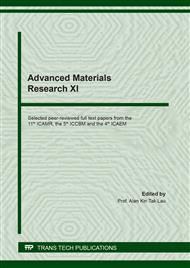[1]
R.M. Andrew, Global CO2 emissions from cement production, Earth Syst. Science Data, Vol. 10, 4 (2017).
Google Scholar
[2]
R.J. Flatt, N. Roussel, C.R. Cheeseman, Concrete: an eco-material that needs to be improved, Journal of the European Ceramic Society, Vol. 32, 11 (2012).
DOI: 10.1016/j.jeurceramsoc.2011.11.012
Google Scholar
[3]
E. Gartner, H. Hirao, A review of alternative approaches to the reduction of CO2 emissions associated with the manufacture of the binder phase in concrete, Cement and Concrete Research, Vol. 78 (2015).
DOI: 10.1016/j.cemconres.2015.04.012
Google Scholar
[4]
J.L. Provis, Introduction and scope, in: J.L. Provis, J.S.J. Van Deventer (Eds.), Alkali Activated Materials, State-of-the-Art Report, RILEM TC 224-AAM, Springer, Dordrecht, (2014).
DOI: 10.1007/978-94-007-7672-2
Google Scholar
[5]
Kioupis, D.; Tsivilis, S.; Kakali, G. Development of green building materials through alkali activation of industrial wastes and by-products. Mater Today-Proc, Vol.5, (2018).
DOI: 10.1016/j.matpr.2018.09.048
Google Scholar
[6]
T. Luukkonen, Z. Abdollahnejad, J. Yliniemi, P. Kinnunen, M. Illikainen, One-part alkali-activated materials: A review, Cem. Concr. Res, Vol. 103, (2018).
DOI: 10.1016/j.cemconres.2017.10.001
Google Scholar
[7]
A. Hajimohammadi, J.L. Provis, J.S.J.V. Deventer, The effect of silica availability on the mechanism of geopolymerisation. Cem. Concr. Res. 41, 210–216 (2011).
DOI: 10.1016/j.cemconres.2011.02.001
Google Scholar
[8]
C. Tennakoon, P. Silva, K. Sagoe-Crentsil, J.G. Sanjayan, Influence and role of feedstock Si and Al content in Geopolymer synthesis, Journal of Sust. Cement-Based Materials, Vol. 4, 2, (2015).
DOI: 10.1080/21650373.2014.979264
Google Scholar
[9]
A. Hajimohammadi, J.S.J van Deventer, Characterisation of One-Part Geopolymer Binders Made from Fly Ash, Waste Biomass Valor Vol. 8, (2017).
DOI: 10.1007/s12649-016-9582-5
Google Scholar
[10]
Z. Abdollahnejad, F. Pacheco-Torgal, J.B. Aguiar, C. Jesus, Durability performance of fly ash based one-part geopolymer mortars, Key Eng. Mater. 634, (2014).
DOI: 10.4028/www.scientific.net/kem.634.113
Google Scholar
[11]
C. Panagiotopoulou, S. Tsivilis, G. Kakali, Application of the Taguchi approach for the composition optimization of alkali activated fly ash binders, Const. and Building Mat., 91, (2015).
DOI: 10.1016/j.conbuildmat.2015.05.005
Google Scholar
[12]
A. Autef, E. Joussein, G. Gasgnier, S. Rossignol, Role of the silica source on the geopolymerization rate, Journal of Non-Crystalline Solids, Vol. 358, 21 (2012).
DOI: 10.1016/j.jnoncrysol.2012.07.015
Google Scholar
[13]
D. Kioupis, Ch. Kavakakis, S. Tsivilis, G. Kakali: Synthesis and Characterization of Porous Fly Ash-Based Geopolymers Using Si as Foaming Agent, Adv. in Mat. Science and Eng., (2018).
DOI: 10.1155/2018/1942898
Google Scholar
[14]
Z. Zhang, H. Wang & J. L. Provis: Quantitative study of the reactivity of fly ash in geopolymerization by FTIR, Journal of Sustainable Cement-Based Materials, Vol. 1, 4 (2012).
DOI: 10.1080/21650373.2012.752620
Google Scholar
[15]
A. Periasamy, S.Muruganand and M.Palaniswamy, Vibrational studies of Na2SO4, K2SO4, NaHSO4 and KHSO4 crystals, Rasayan J Chem, Vol.2, 4 (2009).
Google Scholar
[16]
D. Kioupis, A. Skaropoulou, S. Tsivilis, G. Kakali, Valorization of Brick and Glass CDWs for the Development of Geopolymers Containing More Than 80% of Wastes, Minerals, Vol. 10, 8 (2020).
DOI: 10.3390/min10080672
Google Scholar


